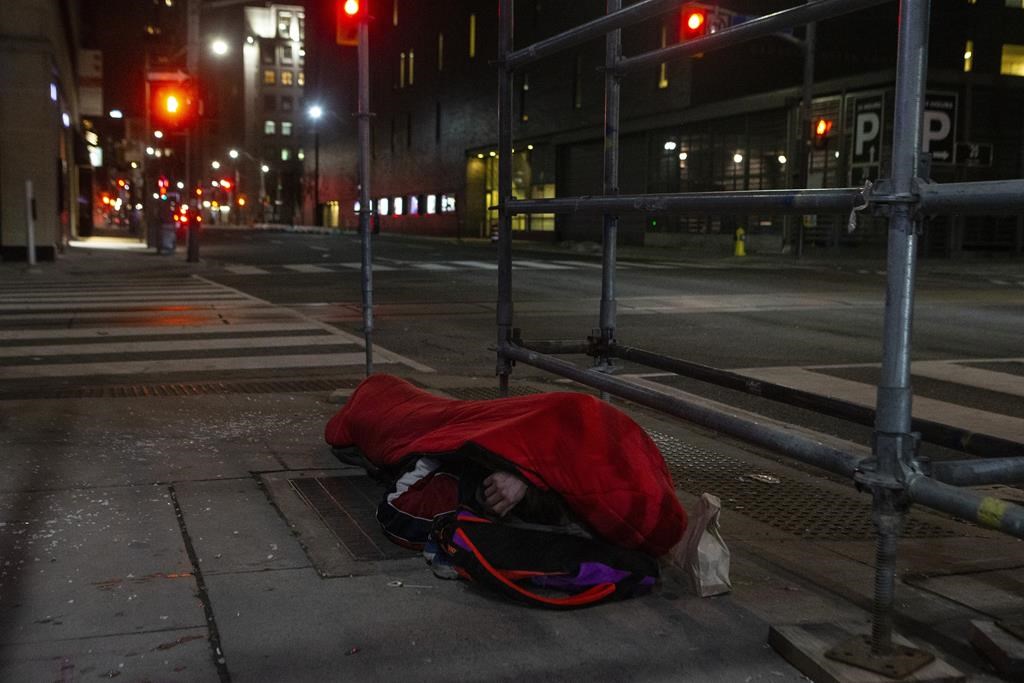
As voters prepare to head to the polls to elect a new mayor of Toronto, two topics remain top of mind: safety along the city’s transit system, and addressing the growing issue of homelessness.
Earlier this year, the Toronto police deployed additional resources to the Toronto Transit Commission (TTC), including officers, in response to an increase in violent incidents along the system.
What’s more, an Ipsos poll in March showed that almost half of the people surveyed (44 per cent), said they felt unsafe riding transit alone.
However, in March, the force announced it would be ending additional patrols along the TTC after almost two months.
After the additional police support was pulled — and besides extra staffing from security guards and special constables — what were left were outreach workers, namely the Streets to Homes Outreach and Support Program.
- Stabbing victim drove themselves to find help, after Mississauga suspect stole phone
- Toronto police investigating after second incident of mezuzahs stolen
- Future uncertain for Ontario college students as federal policy brings cuts, layoffs
- Snowfall, freezing rain to hit parts of Ontario on Boxing Day
The program’s workers provide one-on-one support to people experiencing homelessness in the city, to help address their immediate needs, while also creating a specific housing plan.
James Jeffries, one of many who found themselves without a place to live this year, began experiencing homelessness in November.
“I was on the street, nowhere to go,” Jeffries told Global News. “I had a shopping cart with all my stuff in it. I didn’t even have a tent. I had one quilted blanked and was freezing out there.”
Jeffries said on some cold nights, he would just walk back and forth in an effort to stay warm.

Get daily National news
“There are warming centres, but I had my shopping cart and I had to leave it outdoors,” he said.
James worked with Streets to Homes, and now has his own apartment.
He said he is grateful, but is concerned that if he slips up, he could end up back on the streets.
Cassandra Decker, manager of Streets to Homes, said the Greater Toronto Area has “definitely seen an increase in homelessness.”
“It’s no longer just under our bridges. It’s a known thing. The TTC has seen a spike since the pandemic — folks who are getting out from the elements and riding the TTC,” Decker said.
When it comes to providing support, Ryan Holford, another Street to Homes counsellor, said each person experiencing homelessness is a “unique individual.”
“What I try not to do when I approach my work, or even speak about my work, is make sweeping statements about what homelessness is and how people are experiencing homelessness,” Holford said. “There’s one factor, though, that I can see that we all agree on. These are people who are experiencing homelessness.”
Decker said Streets to Homes goes out and seeks additional housing resources for its clients, beyond what is provided to the program.
“If we had more housing come our way, could we do more housing? And faster? Absolutely,” Decker said.
A lack of affordable housing remains an issue in much of Ontario and is a growing problem in Toronto.
The lack of affordable homes, compounded with a soaring cost of living and a mental health crisis, has left many people struggling to keep afloat.
At a press conference earlier this year, Neil Hetherington, CEO of the Daily Bread Food Bank, said that before the COVID-19 pandemic, the food bank saw 65,000 clients a month. During the pandemic, that ballooned to 120,000 people.
In April, Hetherington said that number had more than doubled to over 270,000 client visits.
Lena, another Streets to Homes client, told Global News that she escaped from an abusive relationship a few years ago.
Global News is not publishing her real name due to safety concerns.
“I literally had to climb out of my window to escape,” she explained, adding that she took a cab in the very early morning to North York.
Lena said after she left, her mental health deteriorated. She had been living in a shelter for two years before Streets to Homes helped her find a place to live.
However, Lena said she continues to struggle with her mental health, and said the supports she needs are just not available.
“I have to go on disability for my mental health,” she said. “I’m 29 years old. Two years ago, I was a manager, I was working, I was paying my own rent. I had everything that I had worked for. And now, it’s like, (nothing).”
According to the Centre for Mental Health and Addiction, before the COVID-19 pandemic, there was a crisis of access to and a demand for mental health care. Now, there is an unprecedented demand for service.
What’s more, city statistics also suggest that as of March, there were almost 11,000 people in Toronto who were considered actively homeless.
With the Toronto mayoral byelection now just weeks away, each of the top candidates has outlined their plans to address homelessness, affordable housing and safety along the city’s transit system.
The plans vary, with some candidates promising to expand the Toronto Community Crisis Centre, deploy additional staff along the TTC, or increase shelter capacity by adding additional beds.
Others have promised to provide cell service alone the TTC or to create mobile mental health clinics.
While more than 100 candidates are vying to become Toronto’s next mayor, Dr. Sean Kidd, Chief of Psychology at CAMH, said these challenges cannot be tackled by one person.
The next mayor will need to be a “good partner” in tackling these issues, Kidd said.
“The last thing we need is a person who is going to come in and be polarizing, who can’t forge relationships because there’s so much common ground,” Kidd said.
“So I’m really hoping that we can get somebody in who can really capitalize on that common ground,” Kidd continued.
Toronto voters will head to the polls on June 26 to elect the city’s next mayor.









Comments